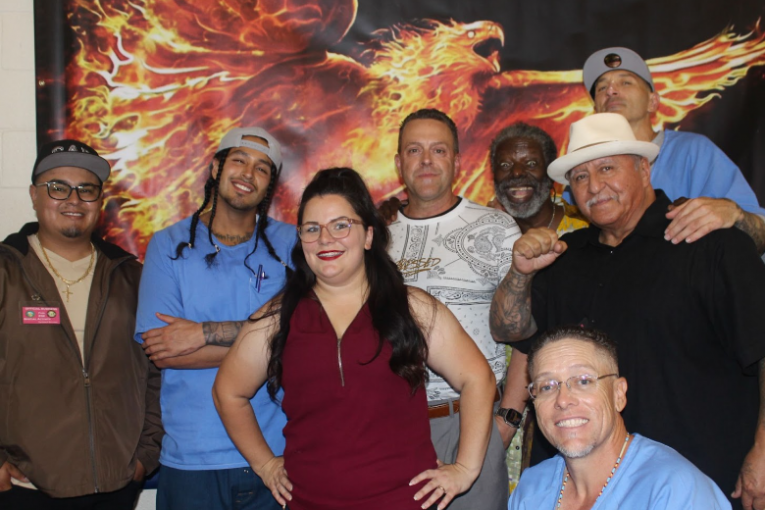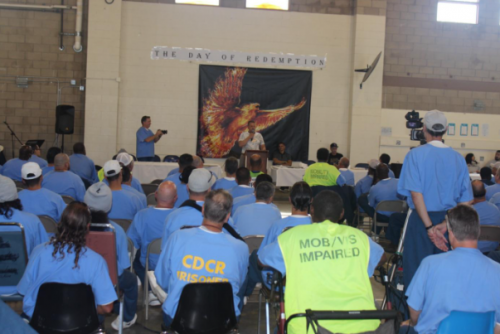
For years, San Quentin Rehabilitation Center and Mule Creek State Prison have been the only carceral communities in California’s gauntlet of over 30 facilities wherein aspiring journalists and photographers are permitted to function in a legitimate media capacity within the confines of prison life.
Until now. In late October, owing to a forward-leaning Warden, Public Information Officer (PIO), and Community Resource Manager (CRM), Valley State Prison (VSP) became the first facility to normalize a journalism mentorship relationship between The Davis Vanguard news organization, the Ben Free Project, and two confined writers and creators who have been widely published beyond the fence line.
Benjamin Frandsen was released from VSP over 22 months ago after serving nearly two decades in prison. Now, off parole, he attends UCLA, hosts the Ben Free Podcast, authors graphic novels for Immortal Studios, operates a nonprofit organization (Ben Free Project), and writes for the Los Angeles Vanguard‘s social justice desk. He is a busy man. He recently made his first return as a free citizen journalist to the very place that last confined him, sporting an “Official Business” visitor badge and holding a digital camera.
“I came to cover the annual MAGIC Day of Redemption public speaker event. They asked me to speak, and I felt compelled to oblige. I wanted to center the lives of the amazing men I left behind, fulfill my nonprofit journalism mentor mission, and show the VSP community a unique version of what transformation looks like.”
Maturity + Accountability + Growth + Inspiration = Change (MAGIC), is a resident-led self-help community sponsored by Christina Mora, a full-time civil servant VSP employee who organized the all-day event. “Before his speech, Benjamin recited a poem he wrote called ‘To Be Heard.’ I think that it’s very much truthful. At the end of the day, everybody just wants to be heard. Everybody just wants to be seen in one way or another. Nobody should be defined by their past, just where they go from here.”
Mora invited Frandsen, a trained public speaker, to speak at and cover the event. “Christina and MAGIC’s resident facilitator Daniel Henson really put together one hell of an event,” Frandsen said. “As an author, memoirist, and journalist, I write. I also interview guests at red-carpet events and have a podcast. I talk for a living. But the truth is, I was masking a series of traumatic flashes that were creeping into my operating system the entire drive up from LA with Michael D. McCarty.”
Frandsen, a Gulf War era veteran, was diagnosed with PTSD while an active-duty Marine, a condition that was not helped by 18 years in prison. “There was a nagging part of me that was still, well, terrified about walking back inside the place that had held me in for so long. For days leading up to the event, I’d been having these nightmares. I’d try to exit the facility and all the officers would laugh raucously, ‘Ha! You thought we were gonna let you out? You are stupid. Go back to your cell.’ It was visceral. But the moment I saw the familiar faces of my guys, and felt their warm embraces, all that nightmare fear melted away.”
As a winner of the PEN America L’Engle-Rahman Prize for Mentorship, Frandsen praised Carmen Maroney, the long-standing Community Resource Manager at VSP, for guiding him into the facility to do stories that humanize residents and showcase the programs supported by the administration. “She really went to bat for me. Warden McVay kindly approved my engagement with the PIO’s office, got me listed as a fixed member of the press with permission to enter the facility. I was enabled not merely to attend and cover the event, but also to finally step into my journalistic mentor role with select prison residents who have already been quite widely published as interview journalists, creative nonfiction writers, and artists. Their accomplishments are extremely impressive, especially when you consider that they have no access to any in-house carceral newspaper or digital magazine platform at VSP. We are re-envisioning what mentorship looks like, journalism style.”
As incarcerated citizens, having a publisher-authorized press role here within The Vanguard newsroom, under the editorial supervision of Frandsen, is a privilege we take very seriously. Being quoted ourselves in the UCLA Daily Bruin as “incarcerated literacy activists” and profiled by The Vanguard for our Barz Behind Bars literacy workshop collaboration with Freedom Reads, has enabled us to be published in Slate, Open Campus, College Inside, the Prison Journalism Project, the American Prison Writing Archive at Johns Hopkins University, and the Columbia University School of the Arts Incarcerated Writers Initiative magazine, Exchange. The Social Justice platform at The Vanguard represents a unique mainstream newsroom partnership that improves the programmatic public exposure of VSP’s most successful service outcomes, while centering the journalism vocational skills of its most qualified incarcerated journalists.
“VSP,” Frandsen said, “doesn’t necessarily need to formalize the build out of say, an in-house newspaper or digital magazine like San Quentin or Mule Creek have, because the most critical piece, digital distribution, is already here. The Vanguard is that enabling umbilical cord.”
VSP’s Media Center resident workers routinely provide photographic and video coverage of events, which the PIO curates and forwards for CDCR’s internal use online via the Inside CDCR platform. However, that digital platform is inaccessible to the over 90,000 carceral state residents holding WiFi-enabled tablets. Also, those grabs are circumscribed by the respective bandwidth of the platform’s editor, and almost never result in a real-world media property placement that memorializes the writer, photographer, or videographer byline for those incarcerated journalists doing the work. “In The Vanguard,” Frandsen said, “VSP now has a newsroom partner that can create powerful resident-curated media.”
We were permitted to shadow Frandsen during the Day of Redemption event. As approved press media, he was allowed to bring his digital camera inside the prison. As part of his journalistic mentorship work, he allowed us to take photos with his camera and capture all of the event elements, engage each of the visiting groups in attendance, and chronicle the story that is Benjamin’s return. Our residents need to see, hear, and touch exemplars like him when they return to the scene of their transformation. They also need to see resident-journalists moving in the room, turning the lens towards them, centering their existence. Prompting them with verbal cues to smile, laugh, and live out loud. Journalism is that unique vocation that actually employs words and visuals to convey to the public the evidence of the transformation happening on the ground in forward-leaning communities like VSP.
The CRMs and community organizations work and volunteer tirelessly within CDCR facilities like VSP. They travel on weekends to share space with the incarcerated, enable these normalizing spaces to exist, and facilitate the humanizing encounters within these gatherings of giving souls. Fresno State’s Project Rebound professors, Circle T Ranch equine therapy facilitators, Legacy Alliance Outreach mentors, Self-Awareness and Recovery community leaders, Anti-Recidivism Coalition former life prisoners, and the carceral program developers from the Ben Free Project—they all meet in the same room to celebrate redemption.
“There’s a phoenix rising in each of us, fellas,” Frandsen told us just as we turned to part ways, “a certain kind of magic in our journeys moving ever closer to what normal feels like.” You are reading a piece of news media written by two incarcerated lifers about the triumphant return of a former lifer, and looking at a photo taken by a lifer. This is journalism. Normal, just got a little closer.
©2023/BenFreeProject.org

Top: Daniel Henson (resident event planner); Michael D. McCarty (professional storyteller and Ben Free Project Director of Carceral Programs); Christina Mora (MAGIC group sponsor); Bottom: Benjamin Frandsen (Vanguard journalist and Executive Director of the Ben Free Project).

Benjamin Frandsen speaks to the crowd of over 300 incarcerated citizens and 50 visitors from various restorative justice organizations at the “Day of Redemption” event in Valley State Prison on October 21, 2023.

Benjamin Frandsen speaks to the crowd of over 300 incarcerated citizens and 50 visitors from various restorative justice organizations at the “Day of Redemption” event in Valley State Prison on October 21, 2023.
